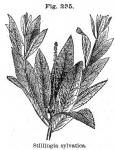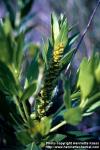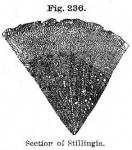Stillingia (U. S. P.)—Stillingia.

 Preparations: Extract of Stillingia
- Fluid Extract of Stillingia
- Compound Fluid Extract of Stillingia
- Compound Troches of Stillingia
- Compound Liniment of Stillingia
- Compound Liniment of Oil of Amber
- Syrup of Queen's Root
- Compound Syrup of Queen's Root
- Tincture of Stillingia
Preparations: Extract of Stillingia
- Fluid Extract of Stillingia
- Compound Fluid Extract of Stillingia
- Compound Troches of Stillingia
- Compound Liniment of Stillingia
- Compound Liniment of Oil of Amber
- Syrup of Queen's Root
- Compound Syrup of Queen's Root
- Tincture of Stillingia
The root of Stillingia sylvatica, Linné (Sapium sylvaticum, Torrey).
Nat. Ord.—Euphorbiaceae.
COMMON NAMES: Queen's delight, Queen's root, Silver leaf, Yaw root.
ILLUSTRATION: Bentley and Trimen, Med. Plants, 241.
Botanical Source.—This plant was named in honor of Dr. Benjamin Stillingfleet. It is a perennial herb, with a glabrous somewhat angled stem, which, upon being broken, gives out a milky sap, and which attains the height of 2 to 4 feet. The leaves are sessile, lance-oblong, tapering at the base, serrulate, and somewhat leathery. The flowers are yellow, on a terminal spike; the male flowers with a hemispherical involucre, many-flowered or wanting, perianth tubular, erose, florets scarcely longer than the bracteal scales; stamens 2 or 3, and exserted. Female flowers with an inferior, 1-flowered calyx; style 3-cleft; capsule 3-grained (Eaton-Wi.).
 History and Description.—This plant is found growing in sandy soils from Maryland to the Gulf of Mexico, and in Mississippi and Louisiana, flowering from April to July. A whitish acrid juice exudes from the plant when cut or broken. It is much more active in its recent state, than when dried, and loses much of its medicinal virtue by age. The root is the part used. As officially described, it is "about 30 Cm. (12 inches) long and nearly 5 Cm. (2 inches) thick, subcylindrical, slightly branched, compact, wrinkled, tough, grayish-brown, breaking with a fibrous fracture, showing a thick bark and porous wood, the inner bark and medullary rays having numerous yellowish-brown resin-cells; odor peculiar and unpleasant; taste bitter, acrid, and pungent"—(U. S. P.). Alcohol or water extracts its virtues, but its best solvent is diluted alcohol.
History and Description.—This plant is found growing in sandy soils from Maryland to the Gulf of Mexico, and in Mississippi and Louisiana, flowering from April to July. A whitish acrid juice exudes from the plant when cut or broken. It is much more active in its recent state, than when dried, and loses much of its medicinal virtue by age. The root is the part used. As officially described, it is "about 30 Cm. (12 inches) long and nearly 5 Cm. (2 inches) thick, subcylindrical, slightly branched, compact, wrinkled, tough, grayish-brown, breaking with a fibrous fracture, showing a thick bark and porous wood, the inner bark and medullary rays having numerous yellowish-brown resin-cells; odor peculiar and unpleasant; taste bitter, acrid, and pungent"—(U. S. P.). Alcohol or water extracts its virtues, but its best solvent is diluted alcohol.
Chemical Composition.—The root of Stillingia sylvatica contains tannin (11.6 per cent), gum, starch, volatile oil (3.25 per cent) of a strong, disagreeable odor, an acrid oil soluble in ether, an acid resin, and leaves (5 per cent) of ash (see Wm. Bichy, Amer. Jour. Pharm., 1885, p. 528, and J. H. Harmanson, ibid., 1882, p. 386). According to Bichy, an alkaloid, stillingine, is present, but this is doubted by E.G. Eberhardt (Lilly's Bulletin, No. 17, Nov., 1891). (For so-called oil of stillingia, see Related Species and Derivatives.)
Action, Medical Uses, and Dosage.—In large doses, stillingia vomits and purges, producing in many instances a peculiar, disagreeable burning sensation in the stomach, or some portion of the alimentary canal, accompanied with more or less prostration of the system. In less doses it is an alterative, exerting an influence over the secretory and lymphatic functions, which is unsurpassed by few, if any other of the known alteratives. It must, however, be fresh or recent material to be of any therapeutic value, and undoubtedly many of the failures to obtain good results in the use of stillingia are due to the fact that preparations from old and worthless material have been employed. It is an American remedy of much importance and value, and is extensively used in all the various forms of primary and secondary syphilitic affections, in which it appears to have a most decided action; also in scrofulous, hepatic and cutaneous affections, in which its administration is followed by the most successful results (J. King). In regard to its effects upon syphilis there appears to be much discordance of opinion among physicians, and this is probably due to the fact that in earlier years it was undoubtedly much overrated, that poor preparations have been employed and that the special conditions favoring its action have not been properly observed. When the specific indications for the drug have been followed the results have been fully as good as have been obtained from any of the antisyphilitics. The cases for its exhibition in syphilitic and other affections are those in which the tissues are feeble and are tardily removed and renewed; the mucous membranes are predominantly affected and the skin secondarily; and the mucous surfaces are tumid, red, and glistening, and secretion is scanty. With these indications it has been very successfully used in syphilitic and strumous diseases, and chronic inflammations with low deposits. It has been found very beneficial in chronic laryngeal and bronchial affections, and in leucorrhoea. Ɣ Small pieces of the recent root, chewed occasionally through the day, have effectually and permanently cured laryngitis and bronchitis. In fact stillingia is one of the most important of laryngeal remedies, not only relieving irritation of that important organ, but proving beneficial in irritative disorders of the fauces, trachea, and bronchiae. It is, therefore, an important cough remedy, and we have observed the irritative winter-cough of years' standing promptly cured with small doses of specific stillingia. A strumous diathesis adds to its adaptability to chronic coughs. This remedy exerts some influence upon the periosteal structures and is applicable to the periosteal pains in old cases of syphilis with tendency to periosteal destruction and the formation of nodes and exostoses, as of the tibia, head, and face. It is likewise said to favorably influence the persistent pains of chronic periosteal rheumatism. Stillingia is a very important remedy, and by improving the lymphatic functions aids in good blood-making and nutrition, and may be taken without harm for a continued period. It is very important, however, that the proper preparations be used. As before stated the root, when long kept, has its active properties impaired; as a rule, syrups and decoctions are of less value than the alcoholic preparations of the fresh drug, as the properties are but imperfectly extracted by water. The stronger alcoholic preparations (as a strong tincture), the fluid extract (which may be given with aromatics, as oil of anise or caraway), and especially specific stillingia, are far preferable to other forms of administration (see Stillingia Liniment). The oil is entirely too acrid for internal use, unless it be well incorporated with some mucilaginous or saccharine substance. But as an external stimulating application, the oil will be found very valuable in many instances. One drop of it placed upon the tongue, and repeated 3 or 4 times a day, is reputed to have proved successful in cases of severe croup. Stillingia liniment, both externally and internally, is an excellent remedy in various forms of croup. Dose of the tincture from ½ fluid drachm to 1 fluid drachm; of the decoction, 1 or 2 fluid ounces; of specific stillingia, 1 to 20 drops.
Specific Indications and Uses.—Feeble tissues, with tardy removal of broken-down material, and slow renewal of the parts; mucous membranes, tumid, red, and glistening, with scanty secretion; skin affections, with irritation and ichorous discharge; laryngeal irritation, with paroxysmal, hoarse, croupous cough; irritation of the superior pharynx just behind the fauces, with cough; winter-cough of irritation; periosteal pain and tendency to form nodes; an important remedy in struma and syphilitic affections.
Related Species and Derivatives.—Stillingia sebifera, Michaux (Sapium sebifera, Roxburgh; Croton sebifera Linné; Excaearia sebifera, Müller). A Chinese tree, also cultivated in the tropics. The seeds are imbedded in a vegetable fat known as Chinese tallow, which is obtained by expressing the bruised fruits previously freed from the kernels. It is solid, without odor, fuses at 44.5° C. (112° F.) and contains a small portion of stearin, but is made up mostly of palmitin. An oil is also yielded by the seeds (see Pharm. Jour. Trans., Vol. XXI, 1891, p. 943).
OIL OF STILLINGIA is a concentrated alcoholic preparation made by percolating the powdered root with full strength alcohol and evaporating the percolate to a creamy consistence. It has a dark-red color, a slight odor, the taste of the drug, and leaves an acrid sensation in the throat and fauces which is persistent in effect. This preparation is prone to gelatinize and precipitate. Often it changes to a brown mush and should then be thrown away as useless. Stillingia yields a colorless fixed oil to proper solvents, which, however, does not carry the medicinal value of the drug. (For remarks by Prof. King and Wm. Saunders concerning this and other similar preparations, see previous editions of this Dispensatory.)

